
 |
A History of Renault and EVs |
If you're 35 or younger and you live in the US, you might be forgiven for asking "Ren-who?" French automaker Renault hasn't sold vehicles in the US since 1989. You might also wonder what they might have to do with electric vehicles. Patience. I'll get to that.
First, let's get one thing clear. Check the title: this page isn't A History of Renault EVs. Renault doesn't have much EV history because they hardly made any until the second decade of the 21st century. So this isn't really about Renault, though I'll give them their due by and by. It's more an excuse to tell the story of three intriguing American EV efforts, where Renault just happened to be standing next to the milepost as the EV wagon rolled quietly by.
FRANCE, MOTHER OF EVs
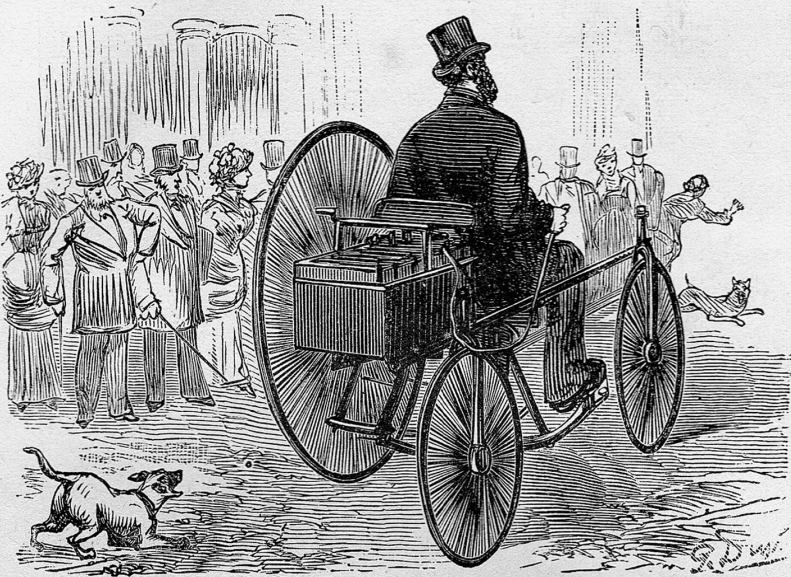 Gustave Trouvé's 3-wheeled EV (Wikipedia)
Gustave Trouvé's 3-wheeled EV (Wikipedia)France, it turns out, is the birthplace of electric vehicles. In 1880, 5 years before Gottlieb Daimler developed his gasoline-powered Reitwagen, Gustave Trouvé fitted a tricycle with a modified Siemens electric motor. He powered the motor with rechargeable lead batteries, invented 21 years before by another Frenchman, Gaston Planté. Trouvé caused a Parisian sensation, especially among the dogs, driving his EV along Rue Valois.
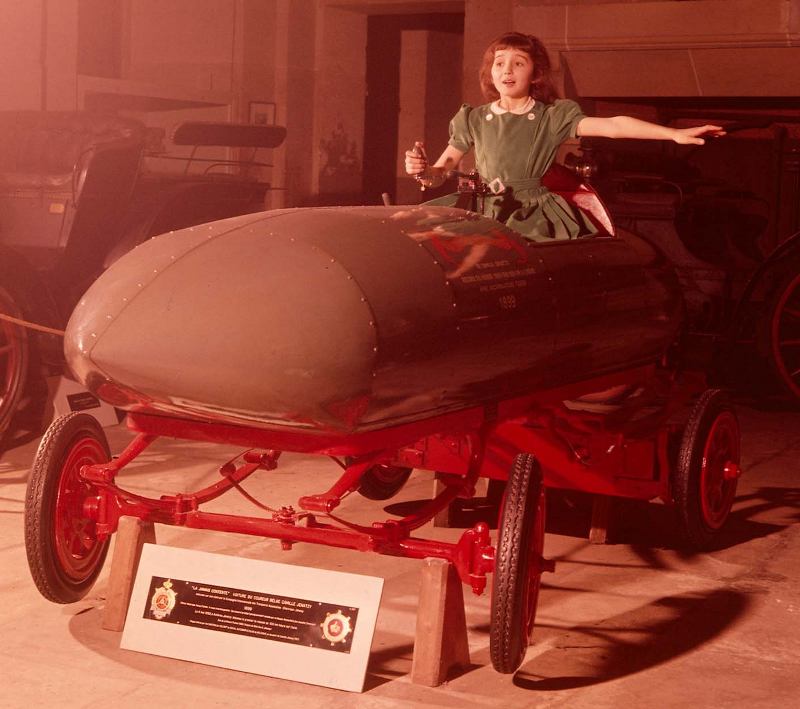 La Jamais Contente (Renault).
I don't know who's "driving," but I'm pretty sure it's not Camille Jenatzy.
La Jamais Contente (Renault).
I don't know who's "driving," but I'm pretty sure it's not Camille Jenatzy.Nineteen years later, in 1899, Belgian electric vehicle manufacturer and race car driver Camille Jenatzy built and piloted the first EV to surpass 100 km/h (60 mph), La Jamais Contente ("The Never Satisfied"). Jenatzy's bullet-shaped car was powered by two 25 kW-rated motors and a 200 volt battery. His record-setting run topped out at 105.88 km/h.

Renault had opened its doors in February of 1898. By the end of the year, when Jenatzy would have been preparing for his series of record-breaking speed runs, Louis Renault and his 2 brothers had sold 12 cars - pretty decent performance for an era long before modern serial production.
Were les frères Renaults aware of Jenatzy's accomplishment? Their first product, the Voiturette 1CV, suggests that the answer is probably non. Their Voiturette ("little car") was powered by a 1-cylinder gasoline engine. With a top speed of only 30 km/h (20 mph), La Jamais Contente would have blown its doors off, had it had any.Other than a brief flirtation in 1937, when they built 35 electric cars for the Paris World's Fair, Renault seemed uninterested in EVs. I guess they preferred the stench of gasoline. And yet ...
ROYAL EV

In 1957, Renault introduced their ICE-powered, rear-engine, rear-drive Dauphine to the US market. In the vocabulary of royal families and succession, Dauphine is the French word for the wife of the king's or queen's eldest son, so you might say that the Dauphine was a princess of a car. It enjoyed surprising success, even outselling the VW Beetle in some areas for a time.
The Dauphine also caught the attention of electric vehicle researchers and experimenters. An EV conversion rule of thumb is that to get useful range with lead batteries, the batteries should amount to at least 1/3 of your vehicle's total weight. To look at it from the other side, for a given amount of lead, a lighter base vehicle will go farther - as long as you can fit all the batteries into it. Well, in the late 1950s and early 1960s, the Renault Dauphine was just about the lightest 4-wheeled vehicle on offer in the US. As a bonus, it was cheap.
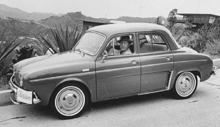 Jascha Heifetz in his EV
Jascha Heifetz in his EVSeveral experimental, prototype, and homebrew Dauphine EVs bubbled up over the next decade or so, including one highly advanced for the day, developed by Bell Laboratories. Bell's had a transistorized controller and regenerative braking - not easy to achieve with the high cost of the day's transistors.
A more conventional Dauphine conversion went to the famous classical violinist and environmentalist Jascha Heifetz. Engineer Bob Borisoff built it for him in 1967 (some sources say 1969), at a cost of $5,000 - the equivalent of about $40,000 today.
The most famous Renault Dauphine-based EV is the 1959 Henney Kilowatt. That's it below, in an eye-catching shade of red. I think it's a nice looking car, but that might be because the shape reminds me of the cars of my childhood.
Some writers have called the Henney Kilowatt the first modern production electric vehicle. Later you'll find out how many were sold, and then you can decide whether you agree.
 1959 Henney Kilowatt (Wikipedia)
1959 Henney Kilowatt (Wikipedia)| Henney Kilowatt Specifications (1959/1960) | |
| Battery Voltage | 72 volts |
| Battery Capacity | 9.5 kWh |
| Nominal Power | 7.1 hp |
| Peak Power (est) | 50 hp |
| Curb weight | 970 kg (2135 lb) |
| Range (advertised) | 105 km (65 mi) |
| Range (reported) | km 80 km (50 mi) |
| Top Speed (advertised) | 100 km/h (60 mph) |
| Top Speed (reported) | 80 km/h (50 mph) |
In the late 1950s, National Union Electric Company (NUEC) had its hands in quite a few cookie jars. Among other enterprises, they manufactured Exide batteries, owned the Eureka Williams Vacuum Cleaner Company, and ran the Henney Motor Company. Henney specialized in custom auto bodies, including ambulances and hearses.
You can probably see where this is going. NUEC made a deal with Renault for 100 Dauphine gliders (bodies without powertrains). Henney beefed up the cars' structure and brakes to handle extra battery weight, then shipped them to Eureka. Eureka fitted them with a custom-designed 7.1 hp motor made for them by GE, a clever 6-step rectactor controller developed by EV pioneer Victor Wouk, and of course Exide lead batteries.
When I first started writing this page, I thought I had a pretty good idea of what the Henney Kilowatt was - a 72 volt lead battery EV. The more I read about it, the more puzzled I got.
Everybody I read agreed on the Renault glider and the GE motor. Then they started talking about the battery, and things got murky. I read that the 1959 model used a 36 volt battery, and the 1960 model a 72 volt. Or was it 72 volts in 1959 and 84 volts in 1960? The problem is that the numbers given for battery type and number, weight, speed, and range don't add up consistently for either of these scenarios.
This shouldn't be so tough to figure out. It's not like we're talking about the 14th century - it was only sixty-some years ago!
In the end, I'm not sure it matters. Every Henney Kilowatt that I've seen in photos or in print, be it 1959 or 1960, has had twelve 6-volt batteries and a 72 volt motor and charger.
If lower voltage Kilowatts were made, most or all of them were probably field-upgraded to 72 volts.
Henney's later promotional literature mentions a "Model B." That may have been the elusive 84 volt version. But I wonder how many of them - if any - they actually sold. The Henney pamphlet quotes a Model B price of $5,995. That was over four times the price of a plain gas-powered Dauphine, and 50% higher than the already-expensive 72 volt Model A Kilowatt. It's the equivalent of more than $52,000 at today's prices.
The Henney Kilowatt sure didn't have Tesla S or even Nissan Leaf performance, but let's face it: 1960's lead batteries weren't fundamentally all that different from the ones that Trouvé and Jenatzy had used early in the century. The improvements had been incremental, as they still are today.
It was always the battery that limited EVs, until almost the end of the 20th century. Then it wasn't the battery any more. It was blatant corporate trickery, and it set the electric vehicle clock back another 15 years. More on that later.
Lead batteries were clunky. They still are. But flip the Kilowatt's lids and have a look. If you've ever done an EV conversion, or even just seen one, I'm pretty sure that you'll appreciate Henney's clean work. You'd almost think that Renault's engineers had planned for it. (Spoiler: they hadn't.)
 The 1960 Henney's business end - a GE motor and six 6-volt battery blocks (Renault)
The 1960 Henney's business end - a GE motor and six 6-volt battery blocks (Renault)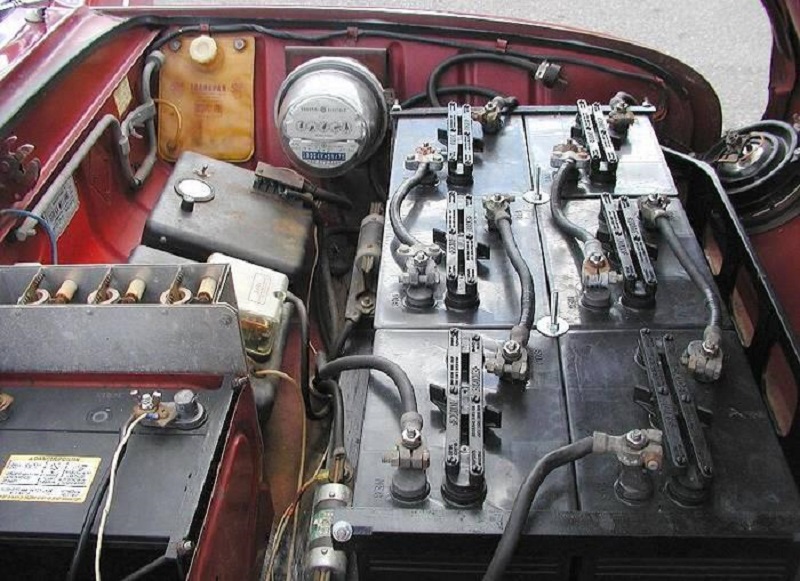 The front compartment has its own kWh meter to monitor your energy use (Renault)
The front compartment has its own kWh meter to monitor your energy use (Renault)Henney Kilowatts were offered in red, grey, and black. At most, 47 were eventually sold. You're welcome to call that serial production if you like.
I'd bet that some potential private owners were put off by the Henney's limitations, and many more by the cost. An ICE-powered Renault Dauphine sold for $1,600, but a Henney Kilowatt would've drained between $3,600 and $6,000 from your bank account. For that kind of money in 1960, you could buy a Chrysler Imperial luxury sedan, or a sporty Corvette roadster.
The EV value-for-money problem was a sad song with many verses. It echoes still, and it shouldn't. An ICEV (internal combustion engine vehicle) has thousands of precisely-machined moving parts in its engine alone. An EV motor has one moving part (OK, 3, if you count the bearings). An EV transmission usually is much simpler than an ICEV's, with only one fixed gear ratio. At any normal manufacturing scale, an EV should be cheaper.
But scale is the problem. Until EVs are at least comparable in price, you can't sell many. Until you can sell enough, they won't be price-comparable. Chicken, meet egg. That's why we needed government subsidies for EVs, and still do.
Only a handful of Henney Kilowatts survive today. There are probably others, but I know of two in France, and four are listed here, here, here, and here in the EV Album.
BUT WHY?
That's the big question that the Henney Kilowatt raises. Why an electric car? Why in 1959?
Cost? In 1959, gasoline was 30 cents a gallon, about $1.88 in today's dollars. For most folks, driving a gas car was affordable. Anyone who wanted to spend less on fuel could trade for a VW Bug or the Kilowatt's ICE-powered sister, the Renault Dauphine. The Kilowatt's $2,000 minimum EV upcharge would have bought over 25,000 litres (more than 6,600 gallons) of gasoline, enough to drive over 420,000 km (260,000 miles) in that $1,600 Dauphine.
 LA smog, 1958
LA smog, 1958Environment? In 1959, pollution wasn't yet much a part of general US discussion. The air was already murky in southern California; thick smog had shut down much of Los Angeles for a while in 1954. But the link between smog and engine exhaust - unburned hydrocarbons and oxides of nitrogen stewing in the sun's rays - wasn't really public knowledge yet.
The eye-watering stink in rubber and steel towns was "the smell of progress." Everyone knew that lead was poisonous, but the oil companies managed to keep leaded gasoline's hazards under wraps until at least 1965.
Who did NUEC think was going to buy this solution to a problem that hardly anyone recognized?
Today's EVs face a similar question. More people recognize the world's environmental problems, thank goodness. It's just that when they choose their vehicles, they put a higher priority on other factors. How many cupholders they have, for example. Seriously.
It makes libertarians grit their teeth, but that's one of the limitations of an unregulated market. Face it: without laws regulating them, today's vehicles would still be a lot like 1959 Fords and Chevrolets. They'd have no emission controls, no seat belts, no crush zones. We needed those changes. Only laws delivered them. Only laws will retire the internal combustion engine and deliver the clean, zero-emission, low-carbon electric vehicles we need today.
SWEET EV

In 1959, as NUEC was designing the Henney Kilowatt, EV engineer Robert Aronson was tinkering with another Dauphine-based electric car, the Mars I. I first read about Mars I over 5 decades ago and assumed that "Mars" was Aronson's nod to the mid-century promise of space exploration and NASA's Project Mercury. Wrong! It was Bob's son's suggestion: the kid was a fan of Mars candy bars. Another bubble burst.
As far as I can tell, Aronson only built a single Mars I prototype, and never manufactured or sold any. However, he did see modest success with his 1967 Mars II. It was based on the Renault 10, another of their featherweight rear-engine, rear-drive sedans.
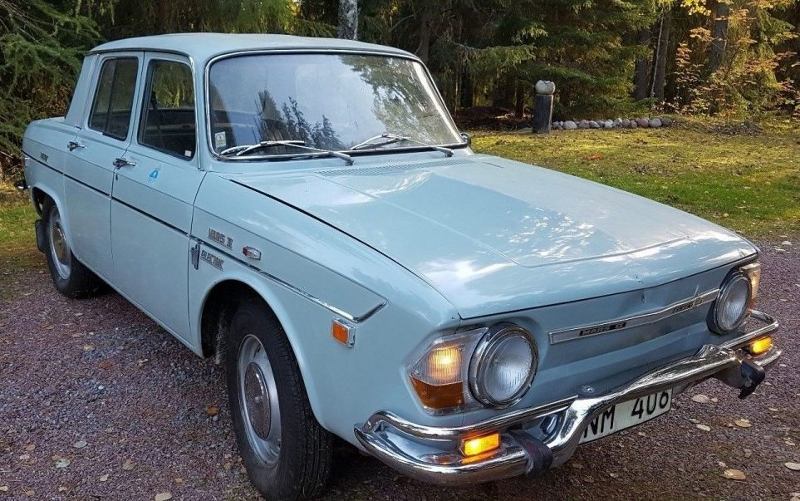 Mars II (Barnfinds)
Mars II (Barnfinds)| EFP Mars II Specifications | |
| Battery Voltage | 120 volts |
| Battery Capacity | 30 kWh |
| Nominal Power | 15 hp |
| Peak Power (est) | 85 hp |
| Curb weight | 1900 kg (4200 lb) |
| Range (advertised) | 200 km (120 mi) |
| Range (reported) | 150 km (95 mi) |
| Top Speed (advertised) | 95 km/h (60 mph) |
| Top Speed (reported) | 115 km/h (70 mph) |
Aronson's Electric Fuel Propulsion (EFP) of Troy, Michigan far outdid Henney in the battery department, stuffing the Mars II's front and rear with twenty big 6-volt blocks. Aronson claimed that they'd last for 800 cycles, or up to 160,000 km.
At 860 kg (1900 lb), the battery was about 45% of the total vehicle weight, vs a more typical 35-40% battery weight for small EVs. The total battery capacity was 30 kWh. Aronson claimed a 200 km (120 mi) range, but that was measured at a constant 50 km/h (30 mph). At highway speed of 90 km/h (55 mph), the range was about 150 km (95 mi).
 EFP tri-polar battery Mk I
EFP tri-polar battery Mk IMost EVs of the time used batteries in the 48-60 volt range. The Mars II's higher voltage meant lower current for a given motor power (power = voltage times current). The lower current reduced power lost to electrical resistance, improved efficiency, and extended the battery cycle life.
In later cars, EFP pushed battery voltage even higher, to 144, 150, 180 volts. Aronson was too far ahead of battery technology, but he had the right idea. Today's factory EVs typically use 300-450 volt batteries.
EFP made much of their "tri-polar lead-cobalt" batteries. The significant refinement in them wasn't so much the cobalt doping, but rather the two extra bus bars at the bottom of each cell. Heat from their resistance generated convection currents, which helped circulate the electrolyte. That allowed for higher discharge rates and, more significantly, faster charging. Aronson claimed that with its 250 amp onboard charger, your Mars II could be charged to 80% full in 45 minutes - if you could get industrial 3-phase power to your garage.
The Mars II had a DC motor rated for a continuous 15 hp, but capable of much more for short periods. By no means was it a race car, but it could cruise fairly comfortably at 80-90 km/h (50-55) mph, with a range of around 150 km (95 mi). EFP gave the top speed as 90 km/h (55 mph). With the motor series-field shunt in the circuit, it would actually do 115 km/h (70 mph) or more, though the usable range at that speed dropped to about 90 km.
 An EFP Charging Point
An EFP Charging Point To show that he was serious about making EV highway travel practical, Aronson assembled a prototype Electric Car Expressway. He established charging points at 5 Holiday Inn locations along I-94 between Detroit and Chicago - Ann Arbor, Jackson, Kalamazoo, Benton Harbor, and South Bend. You'll find other locations for these stops listed elsewhere on the net, but I'm pretty sure this list is right, since I got it from someone who drove the route more than once in a Mars II. It allowed for charging stops every 80-100 km (50-70 miles), comfortably within the car's highway range.
Each location put up a small open shelter behind the motel. It had 200 amp 3-phase AC electrical service and an "Electric Car Charging Station" sign. Unlike much public charging today, these stations were free and always open. No fussy mobile phone apps or RFID cards needed - just pull up and plug in. While you waited for your 45 minute charge, you could down coffee and/or snacks in the motels' restaurants. Nobody using the Electric Car Expressway arrived at his destination hungry or thirsty!
 The Mars II's 250 amp charger and other components lived on the driver's side of the front compartment. Check
out the heavy AC power cable. (Craigslist)
The Mars II's 250 amp charger and other components lived on the driver's side of the front compartment. Check
out the heavy AC power cable. (Craigslist)With 40+ years between them, it's not a fair comparison, but I think it's interesting to look at how the 1968 Mars II stacks up to the 2011 Nissan Leaf. Warning: the range and efficiency comparisons here are iffy, since such standards as EPA and WLTP didn't exist in 1967. I'm using range reports from Leaf drivers and from a former EFP employee.
| 1968 EFP Mars II | 2011 Nissan Leaf | |
| Battery Voltage | 120 volts | 345 volts |
| Battery Capacity | 30 kWh | 24 kWh |
| Battery Weight | 860 kg (1900 lb) | 295 kg (650 lb) |
| Battery Specific Energy | 35 Wh/kg | 81 Wh/kg |
| Min Charging Time (20-80%) | 45 min | 30 min |
| Max Motor Power | 120 kW (est) | 80 kW |
| Curb Weight | 1900 kg (4200 lb) | 1545 kg (3400 lb) |
| Power/Weight | 0.063 kW/kg | 0.052 kW/kg |
| Top Speed | 120 km/h (75 mph)(est) | 150 km/h (95 mph) |
| Range | 150 km (95 mi) | 160 km (100 mi) |
| Efficiency | 20 kWh/100km (315 Wh/mi) | 15 kWh/100km (240 Wh/mi) |
The Leaf's vastly better aerodynamics and lower weight give it a big lead in top speed and energy efficiency, but look at how similar the range is! If I'd compared the Mars II to a 2020+ Leaf with a 62 kWh battery, the result would have been very different. From 2011, EV batteries progressed more in a decade than they had in the previous century.
The 35 Wh/kg specific energy for the Mars II battery is quite good for lead, especially of that vintage. The Leaf's 81 Wh/kg looks low for lithium. However, I suspect that its 295 kg weight includes the battery tray and mount. The Mars II battery weight is probably the total of the 6 volt blocks only. The Leaf's 24 kWh would also be the usable capacity; modern EVs' battery computers reserve between 5% and 20% of the battery capacity to extend the battery life. The Mars II's battery computer was its driver.
With its low-mounted battery, the Leaf's handling would have to be better. Contemporary reports didn't give the Mars II high marks in that department. It's no surprise that the Leaf is a safer, more civilized EV, but given its handicaps, the Mars II fares surprisingly well in this contest.
All in all, EFP found homes for somewhere between 42 and 115 Mars IIs - different sources give different numbers. Again, most went to deep-pocketed electric utilities.
Only a few are still rolling along. One reason for the low survival rate is the Mars II's sheer mass. EFP's assembly workers bolting skinny 165-15 radial tires onto the 2-tonne car called it "an elephant on roller skates." Those 1900 kilograms were far beyond anything that Renault's engineers had imagined. The car literally groaned and creaked. Over the years, the poor little Renault's body seams pulled apart from the strain.
After the Mars II, EFP sensibly left Renaults behind in favor of larger, sturdier vehicles better suited to their monstrous batteries - AMC Hornet Sportabouts, then Chevrolet Malibus, El Caminos, and GM A-body wagons.
SPOTTED EV
 Fuel queue (Lib of Congress)
Fuel queue (Lib of Congress)Fast-forward five years. In October of 1973, a coalition of mideast states led by Syria and Egypt attacked Israel on Yom Kippur, invading the Sinai Peninsula and the Golan Heights. The US took Israel's side, resupplying their military. In retaliation, Arab members of the Organization of Petroleum Exporting Countries (OPEC) imposed an embargo on petroleum shipments to the US and several other Western nations.
The oil cutoff hit hard. US fuel refineries shut down. Filling stations - when they had fuel - limited customers to 8 or 10 gallons, not a lot for big, heavy 13 mpg V8 sedans. Suddenly a car you could "fill up" at an electrical receptacle in your own garage sounded pretty good.
Now that Bob Aronson's EFP was converting big American cars, one of the EV entrepreneurs who stepped in to fill a perceived need for more modest EVs was Chandler Waterman. Waterman established his EV company, U S Electricar, in Athol, Massachusetts.

In 1959, the lightest car on offer in the US had been a Renault. In 1967, it was a Renault. In 1979, it was still a Renault.
For his rolling chassis, Waterman adopted the Renault R5. Renault had re-named it Le Car for US showrooms. U S Electricar dealers got a re-re-named EV: the Lectric Leopard.
The Lectric Leopard may have shared the Renault badge with the earlier Henney Kilowatt and Mars II, but its design process was quite different. Waterman didn't turn to a vacuum cleaner company for his motor, and he didn't commission a controller from an EV-experienced electrical engineer.
 Lectric Leopard (Lee Hart)
Lectric Leopard (Lee Hart)| US Electricar Lectric Leopard Specifications | |
| Battery Voltage | 48 volts |
| Battery Capacity | 12.6 kWh |
| Nominal Power | 20 hp |
| Peak Power (est) | 48 hp |
| Curb weight | 1125 kg (2480 lb) |
| Range (advertised) | 100-130 km (60-80 mi) |
| Range (reported) | 80-100 km (50-60 mi) |
| Top Speed (advertised) | 90 km/h (55 mph) |
| Top Speed (reported) | 80 km/h (50 mph) |
The conversion process was straightforward. Waterman bolted an adapter and Prestolite forklift motor in place of the R5's gas engine. He filled the space above it with 6 golf car batteries, and added 10 more - reportedly rather casually secured - behind the rear seat. The total battery mass was 450kg (990lb), a respectable 40% of the car's curb weight.
Unlike the Kilowatt's more sophisticated 6-step controller, the Lectric Leopard's accelerator had just 3 positions: off, low, and high. These steps fed the motor 0 volts, 24 volts, or 48 volts.
With such coarse speed control, driving a Leopard smoothly was a challenge. Often neither of the 2 speeds was the one you really needed. The 4-gear transaxle helped, but you usually had to keep switching between the pedal positions to stay close to your target speed.
Hitting the go pedal on the green light made for an unpleasant lurch - a hazardous one, if another car or a pedestrian happened to be in front of you. You had to slip the clutch, like on a stick shift gas car, but more so.
Of all the Lectric Leopard's annoyances, the crude accelerator action was probably the most annoying. It's the one that today's hobbyists restoring Leopards usually fix immediately, by fitting a modern electronic controller. Back in 1979, you probably would have accepted that kind of quirk on your own homemade EV conversion. But in an EV that cost you $11,000 - the equivalent of $45,000 today - you might be forgiven for expecting more polish.
 Lectric Leopard wiring (source unknown)
Lectric Leopard wiring (source unknown)I wasn't there, but it seems pretty clear to me that Waterman was trying to make an affordable EV. With 16 batteries, he could easily have copied Henney's smoother rectactor controller. But that would have added several hundred dollars to the car's already high cost.
He'd started with a handicap, too, because unlike Henney, he couldn't get Renault gliders. He had to spend more on fully assembled R5s, then take another fiscal hit in the labor to gut them of their ICE bits, before he could even start fitting his EV drivetrain.
Given that, the Lectric Leopard "EV surcharge" could have been worse. Look at the Henney Kilowatt: 125% to 275% more than a gas-powered Dauphine. The later Solectria Force hatch, admittedly a much more refined EV, was $26,000 vs $8,000 for the gas Geo Metro it was based on - a 225% EV premium. Against those numbers, the Lectric Leopard's 120% upcharge might not have seemed as ferocious.
The problem is that "It's expensive, but it could be worse" just isn't all that persuasive. U S Electricar had to convince potential customers to pony up more than double the gas version's price, and to accept the Leopard's quirks, rough edges, and limited performance.
It made for a tough sell. But the 1973-74 fuel queues were still fresh in buyers' memories, so US Electricar sold 79 cars in 1979 alone - more than Henney had shifted in both 1959 and 1960.
In 1980, Electricar aimed higher, with a goal of selling 3,000 cars. Waterman had made a deal with Fiat to buy Stradas without drivetrains. Things were looking up!
Or not.
The US EV climate was changing, and not for the better.
DRIVING IN REVERSE
That autumn, Ronald Reagen defeated Jimmy Carter for the US presidency. He moved into the White House and had Carter's solar water heater torn off the roof. On television, he flashed his trademark affable smile, purring "Isn't it nice to see the gallons add up faster than the dollars?"
The Mideast Oil Embargo had eased, oil was flowing again, fuel prices were down. EVs were last year's idea - no, make that last decade's. EV development was defunded, EV researchers laid off and scattered to the winds, EV projects and papers hauled to landfills. US EV progress went into reverse for the rest of the decade. When it finally started moving forward again, progress was slow and fitful.
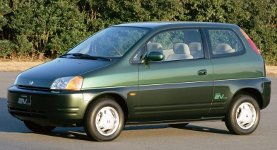 Honda EV Plus (1997)
Honda EV Plus (1997)The 1980s and 1990s came and went. The 21st century dawned. GM, Honda, and Toyota built outstanding limited-production EVs, leased them, clawed them back, crushed them. GM sued California for daring to require EVs. Several other automakers joined GM. Outrageously, so did the George Bush administration. Nickel metal hydride batteries were tried for EVs, proven reliable and practical, and summarily dismissed from EV use.
Europe aimed to reduce its energy use and carbon emissions. EU automakers answered with higher-MPG Diesel engines. Some of them quietly, deliberately, and illegally programmed their Diesel engine computers to cheat, belching out up to 10 times the legal limits for oxides of nitrogen when the cars weren't being tested for their emissions.
The legal smackdown and public scandal that followed - Dieselgate - set the stage for a major change. Quite unexpectedly, the company taking the most cheating heat, Volkswagen, started making choking noises that sounded a little like "we'll make electric vehicles."
Renault idled along. They dabbled a bit in EVs, but you couldn't walk into a Renault dealer and drive out in an EV ...
... until you could.
FORWARD AT LAST

In 1996, VIP manager Carlos Ghosn was assigned to turn Renault's flagging fortunes round. In the years that followed, he forged a collaboration between Renault and Nissan, later adding Mitsubishi. The automakers' reationship was sometimes a rocky one, but it helped to bring about the economies that the companies thought they needed to survive - largely, I'm sorry to say, on the backs of laid-off workers. So what else is new?
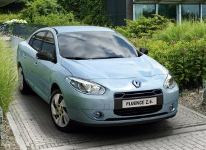 Renault Fluence ZE
Renault Fluence ZEUnlike most amoral, axe-swinging corporate comeback CEOs, Ghosn looked to the future, and there he saw electric vehicles. That was highly unorthodox in the change-averse vehicle business. Without Ghosn, I don't think the Nissan Leaf would have been launched in 2011 - if ever.
EVs at Renault soon followed. Their first, introduced in early 2011, is nearly forgotten already. The Fluence ZE (page in French) was mainly intended for Better Place, a battery-exchange venture. It was an EPTO (Electric Power Train Option) reworking of Renault's C-segment Megane sedan, stretched a bit to make room for a 22 kWh battery behind the back seat. At one of Better Place's swap shops, a flat battery could be swapped for a freshly charged one in about 3 minutes - but not in France. Better Place operated mainly in Israel and Denmark. After they went under in 2013, the Fluence just sort of faded away.
 2012 Renault Zoe (favcars.com)
2012 Renault Zoe (favcars.com)Renault's next EV launched in 2012. Smaller, sleeker, and more nimble than its cousin the Nissan Leaf or the Fluence, the Renault Zoe notched right into Europe's size and utility sweet spot, the B-segment supermini. By selling Zoe batteries not included and leasing batteries to owners, Renault kept the purchase price low and nullified potential customers' worries about future battery depreciation. By 2016, Zoe was setting European EV sales records.
Renault tweaked Zoe over the following years, boosting its 22kWh battery to 41kWh, then to 52kWh in 2020, for a WLTP range of 400km.

Carlos Ghosn is gone now, pushed out in 2018 over Japanese allegations of financial crimes, a literal international fugitive. But Renault hasn't abandoned its EV program. They can't, any more than Volkswagen can. In June of 2022, the EU parliament voted to require that all new cars and vans sold in the EU be zero emission vehicles from 2035. Add to that the EU's ever-stricter limits on CO2 corporate fleet averages, and all the automakers who expect to keep selling vehicles in Europe are scrambling to develop and build EVs that Europeans will actually want to buy.
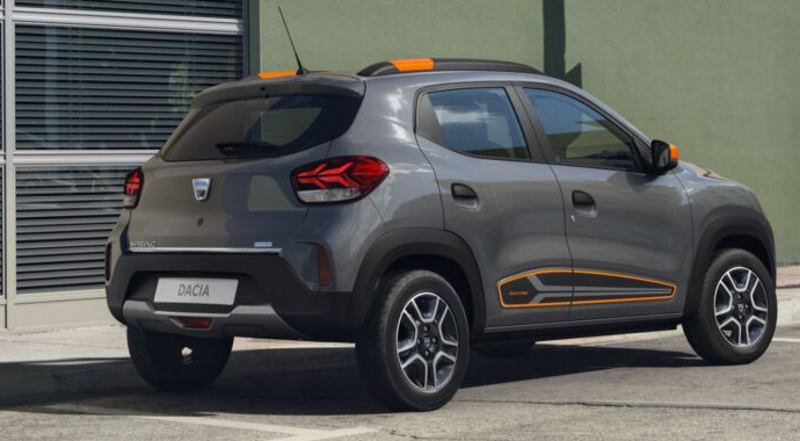 2022 Dacia Spring EV (Renault)
2022 Dacia Spring EV (Renault)Rumors are flying that Renault may let its flagship EV Zoe languish, or even replace it with a nostalgic electric reboot of the old R5 (see the Lectric Leopard above). I think that would be a mistake, but who am I to say?
Whichever way they turn on the B-segment, it looks like they have another rising EV winner, the Dacia Spring. The Spring is a small, A-segment city EV from Renault's cut-price Dacia division, cheaply built in China and selling fast at around 12,000€. Its 250 km range is pretty mediocre by current standards, but it looks as if plenty of European drivers are willing to forgive the range for the price.So here we are. An essay that wasn't supposed to be about Renault's EV history because they didn't have any found a little of it after all. I won't be here to see it, but I wonder which mainstream automakers - if any! - will still be around to have their electric vehicle history reviewed 50 or 100 years from now.